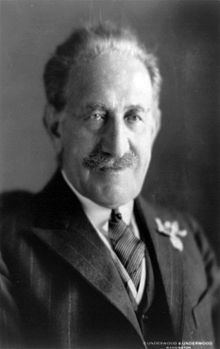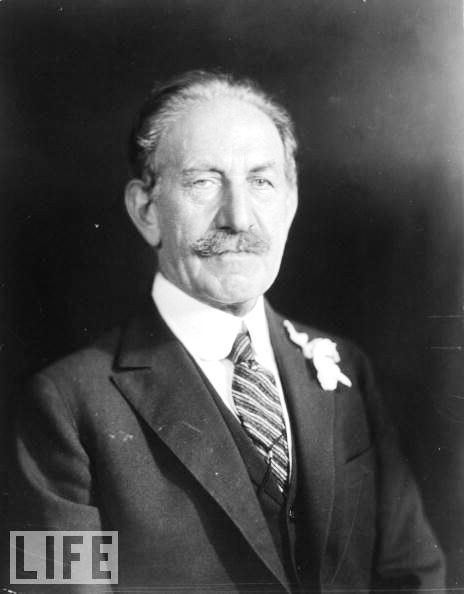Nationality American Spouse(s) Minnie Carl Name Samuel Untermyer | Role Lawyer Religion Judaism | |
 | ||
Books Hobson's Choice Between Government Ownership and Bankruptcy of the Railroads | ||
Untermyer Park and Gardens
Samuel Untermyer (March 6, 1858 – March 16, 1940, although some sources cite March 2, 1858, and even others, June 6, 1858) was a prominent American lawyer and civic leader. He is also remembered for bequeathing his Yonkers, New York estate, now known as Untermyer Park, to the people of New York State.
Contents
- Untermyer Park and Gardens
- Experimental Boiling Water Reactor EBWR
- Life
- Legal Legacy
- Political Involvement
- Untermyer Park
- Private Life
- References

Experimental Boiling Water Reactor (EBWR)
Life
Samuel Untermyer was born in Lynchburg, Virginia but after the death of his father the rest of the family moved to New York City. He was educated at the College of the City of New York and received his LL.B. from Columbia Law School in 1878.
Untermyer was promptly admitted to the bar, and started practice with his half-brother Randolph Guggenheimer in New York city. A younger brother, Maurice Untermyer, was later admitted, and then in 1895 Louis Marshall joined and the name was changed to Guggenheimer, Untermyer & Marshall, a name it held for 45 years.
After admission to the bar, he soon gained fame as a lawyer, focusing on corporate law. Untermyer became a staunch advocate of stock market regulations, government ownership of railroads, and various legal reforms. He was also a prominent Zionist leader and the first attorney to earn a million dollars on a single case. He is also remembered for donating his home to the people of Yonkers, New York. The property is now known as Untermyer Park.
Untermyer frequently attended the Democratic National Convention as a delegate. As an active Zionist, Untermyer was also an able advocate for the Zionist liberation movement, and was President of the Keren Hayesod, the agency through which the movement was conducted in America.
Legal Legacy
Between the start of his practice and the end of 1921, Samuel Untermyer was counsel in many celebrated cases covering almost every phase of corporate, civil, criminal and international law, specifically:
Untermyer was a staunch advocate of stock market regulations, government ownership of railroads, and various legal reforms.
Political Involvement
Samuel Untermyer was a delegate to Democratic National Convention from New York in 1904, 1908, 1912, 1916, 1932, and 1936. He was also a delegate to the New York state constitutional convention in 1938.
Untermyer also advocated the Zionist movement and was President of the Keren Hayesod, the agency through which the movement was then and still is conducted in America.
Untermyer Park
Untermyer developed elaborate gardens at his 150-acre riverside estate "Greystone", in Yonkers, New York, on land adjacent to the Hudson River. Greystone had previously been owned by defeated Presidential candidate Samuel Tilden, and was purchased by Untermyer when Tilden died in 1886. When Untermyer himself died in 1940, his plan had been to donate the whole estate to the Nation, or the State of New York, or at least to the City of Yonkers. Eventually the city of Yonkers agreed to accept part of the estate gardens; this parcel of land was renamed Untermyer Park in his honor. It was added to the National Register of Historic Places in 1974.
Private Life
Untermyer was born in Lynchburg, Virginia on March 6, 1858 to Isadore Untermyer and Therese Laudauer, both of whom were German Jews who emigrated to the United States from their native Bavaria. His father, who had been a lieutenant in the Confederate Army, died in 1866, soon after the close of the Civil War. The family then moved to New York City.
On August 9, 1880 he married Minnie Carl, daughter of Mairelius Carl of New York City. They had three children, Alvin, who served in the 305th Field Artillery in France during the Great War; Irwin, a justice of the Appellate Division of the New York State Supreme Court, and Irene, a philanthropist who married Louis Putnam Myers and, after his death, became the wife of Stanley Richter. Upon the outbreak of World War I, Untermyer, his wife, and two servants were vacationing in Carlsbad, Germany, and returned to the United States aboard the Baltic via London in late August.
Untermyer died March 16, 1940, in Palm Springs, California. His body was interred at a family plot that he established in Woodlawn Cemetery, Bronx, New York, which features sculpture by Gertrude Vanderbilt Whitney. His obituary was published in the New York Times (March 17, 1940, p. 1).
